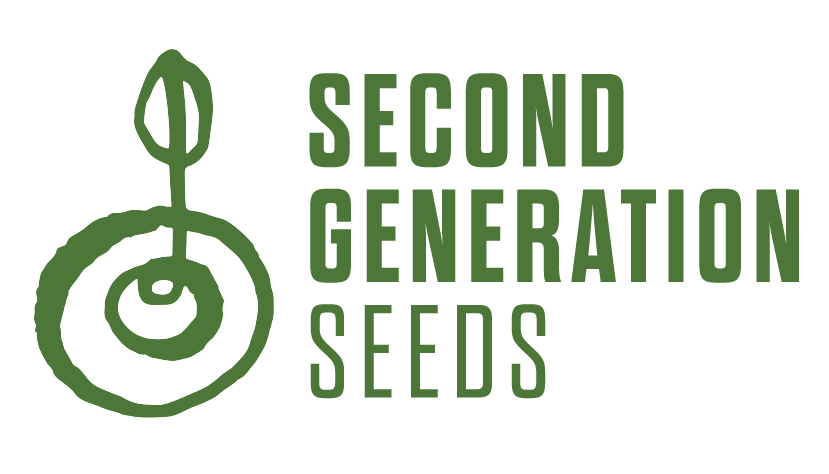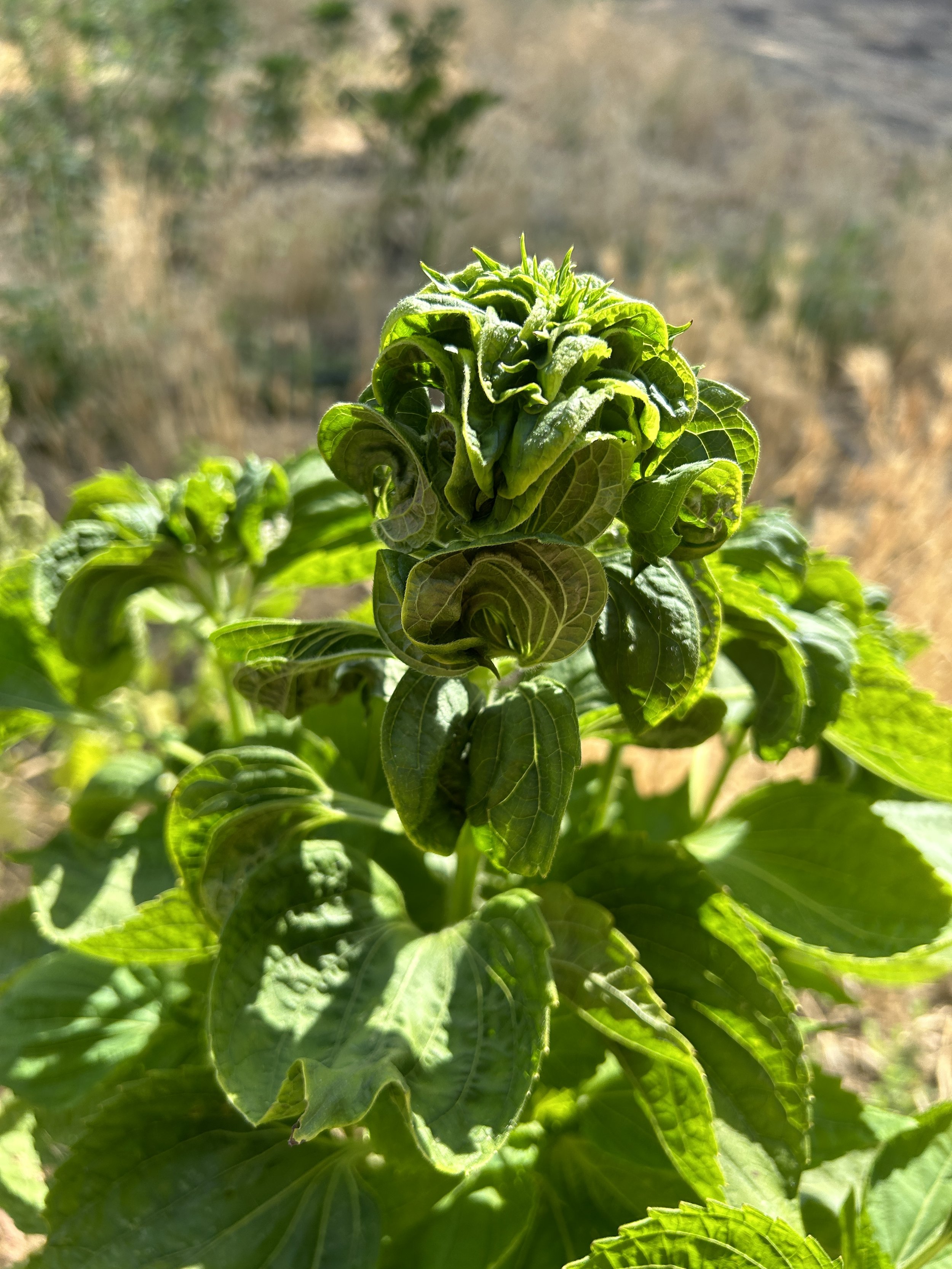Ssampler Pack Week 2: Kkaennip Core
Three cultivars of Korean Perilla: 38N, “Deulkkae”, and “Dae Yeup Deulkkae”
When I first started growing kkaennip, almost 15 years ago, I was amazed at how responsive my Korean American community was. Presenting someone with a bundle of leaves prompted a consistent experience where I watched them bring the leaves to their faces, and seemingly get transported to a distinct sense memory as they took in the aroma. I heard reflections on what it meant for people to have sustained access to “our” perilla, how the flavor had no substitute. The depth of this relationship, and the intensely visceral familiarity I’ve gotten to witness and personally experience, contrasts with the information that was available to me from a western science lens. Perilla was treated indiscriminately, and I encountered so many people who persisted in arguing that my belief in the uniqueness of various cultivars was mere ethnocentrism. We even heard that from within our own community, as friends wondered why their halmoni scolded them for bringing them shiso, insisting that it was not the same as kkaennip. But beyond the semantics, there’s a troubling correlation between the narrowing of language, and the potential loss of genetic diversity, as cultivars get conflated with one another, as multitudes become monolithic.
What’s “ours” is not singular
It’s happened to me across so many crops. I’ve been happily plugging along, content to be growing “the” Korean variety of something, when I stumble into a more vast pool of diversity than I had previously considered. Through the years, as folks found out about my farm, I was gifted many peoples’ grandparents’ kkaennip seeds. When there was no request to maintain the variety as it was, I would introduce them to my population that was being continually adapted to the hot dry summers of the valley. Different varieties had different combinations of flavors, they responded somewhat differently to our growing conditions, but all of them were consistent in their general appearance, and their seeds were always gray-brown. I felt like this would keep my population diverse enough, and would continually reflect what was preserved and maintained by Korean immigrants through the years, while remaining “true” to the traits that rendered them legible to Koreans.
Two years ago, an article was published by researchers in Gangwon Do, detailing an effort to construct a core collection of perilla native to Korea. This core collection would analyze accessions held by their gene bank, to determine how to maintain the maximum amount of genetic diversity within the fewest varieties. Going into this wormhole, I better understood the novel genetics within the Korean gene pool for perilla. The Rural Development Administration had started collecting varieties of native and landrace varieties in the early 1980’s, developing commercial cultivars from this stock. From the over 400 varieties they preserved, researchers distilled them down into 44 accessions which managed to maintain the allelic richness-100% of the alleles held within the entire collection. This research was prompted in part, by an understanding that public resources like the RDA Genebank face increasingly precarious futures. It seems unlikely that institutions will be able to continually grow out hundreds of varieties, keeping each population healthy and robust. Simultaneously the genetic diversity existing in wild spaces or as hyper-local varieties maintained by farmers and peasants is endangered by different forms of development, and an increasing reliance on commercial cultivars. It was heavy to learn about the multitudes of stories and distinct pathways contained within the perilla genome as it evolved and branched within the Korean peninsula while simultaneously recognizing how imminently we may lose them.
Perilla dendrogram depicting degrees of similarity and difference between Korean strains of Perilla
Journey to the west
In the late 1800’s, a nascent USDA began funding plant collecting expeditions across the world. The nature of these collections is a topic for a lengthy series in the future, but for our purposes here, I wanted to note that Perilla from Korea first makes its way to the US in 1910. The notes are minimal, as many times the plant collectors had no means to interact with or consult local growers.
Entry from the USDA Journal from 1916.
While many of the varieties taken from Korea are now just documented as historical archive, there are 3 varieties still maintained. We requested two of them referred to as “Deulkkae” and “Dae Yeup Deulkkae”, and received seeds this past spring.
Return and restore
When I opened the package from the USDA, I was struck instantly by how different these seeds were from any that I’ve known. Dae Yeup Deulkkae is large and white, while Deulkkae is small, oblong and light brown. We’ve been growing them out this past season, noting their general growth characteristics, adaptivity, and now, flavor.
Dae Yeup Deulkkae seeds
Of the 75 seeds planted, we had 30 germinate and make it to the field
Deulkkae seeds
Much better germination with Deulkkae, 50 plants in the field
Dae Yeup Deulkkae is a commercially released cultivar. I found the breeders’ application for a plant variety protection from the Korean government in 1993, claiming it was produced from crosses made in the 90’s that were referred to as the Suwon Series, bred for both leaf and seed production. This variety had a low germination rate, and seedlings struggled, but the plants that were healthy enough to make it to the field managed to grow rapidly once established. The leaves tend to curl at the sides, and my daughter always remarks that they look like taco shells. A few plants also started flowering already, and their growth indicates a certain level of confusion. We’re curious enough to try to find varieties with staggered flowering times to accommodate a wider range of suitable places for seed production, so we’ll save seeds from these, but prefer to wait to see when their ideal flowering period is.
Disoriented flowering in Dae Yeup Deulkkae
Deulkkae seems to be a variety collected in Korea, but not one that was a commercial cultivar. I’ve noticed that these smaller, brown seeds are more consistent with types grown in northern provinces like Gangwon Do. Germination was significantly better, but seedlings were varied: some had pink stems (~70%), while others were green. The pigment in the stems has persisted, but for the most part, they are uniform beyond that. They have struggled the most in our hot climate, and seem like they would prefer more water.
Differences in stem coloration in Deulkkae
We are beyond excited to get to know these two varieties, and to share them with you! We’re in the process of trying to access over 50 varieties from the Korean gene bank to steward at our farm, in the hopes of perpetuating a fuller spectrum of characteristics that developed within Korea. Within their genes, varieties may hold potential traits rendering them stronger in the face of certain challenges, or more well suited to certain applications.
Share your feedback here or join the conversation here









